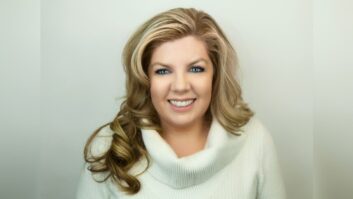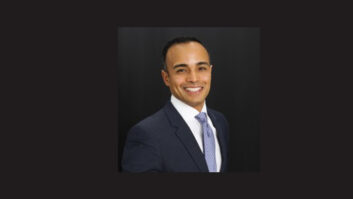When I turned 16, I got a Third Class FCC license and presented myself at KGAF(AM), the local station in my hometown, Gainesville, Texas. My timing was perfect because they needed a weekender. In those days, they were live/local in all shifts, and being a licensed warm body was about all it took to land a gig.

The Pacific Recorders BMXIII console, 11 Software Jockey Pro automation on the computer screen, three Shure SM 5-B microphones, Gentner TS-612 broadcast phone system and Fostex powered monitors. Eberhart also notes that this picture shows the “only real relic from the original 1947 building, the “ON AIR” light, which we restored and works!” The station was your typical small market-station at the time. Country format, local spots, remotes, sports and news were king. At one time, I had a two-way radio in my car (long before cell phones) and helped out covering car wrecks while out cruising at night with my high school buddies. I would go on the air live from my bright red 1966 Chevy Impala, thinking it was pretty cool stuff.
In high school, I worked at KGAF from 4 p.m. until signoff at midnight, and when I graduated, I went to work in nearby Sherman, Texas, at KIKM(AM), a full-fledged top 40 station. After a couple of years I landed at the famed KVIL(FM) in Dallas and worked there for many years, absorbing everything I could learn from the staff headed by Ron Chapman. In the ensuing years, I did afternoons at KLUV(FM), mornings at KDMX(FM) and even a stint doing TV helicopter traffic reporting at Fox 4 TV in Dallas. Later, I spent 20 years at ABC Radio Networks/Citadel/Cumulus Media, working part time while being a Mr. Mom.
In 2008, I made a deal to buy into the company that owns my old hometown station. I have exclusive rights of management in operating KGAF.
Everything had come full circle. I was now running the station where I started.
I had big plans, but the first order of business was revamping the entire station. It was still located in the same 1947 building, which was in disrepair; the equipment was much the same as I operated in high school while working there and had to be replaced. We found old logs in boxes with my signature on them from the 1970s! The city sent out a large industrial dumpster, and we filled it four times.
We installed new computers, microphones and audio processing. It still looked funky, but it began to sound great.
Our first night on the air, we looked around and realized we hadn’t had lunch or dinner so we ordered a pizza. When the delivery guy showed up, he said, “I didn’t know there was a radio station here.” We had our work cut out for us.
It took months and months of work to just get the station cleaned up. The station had billing, but the entire business, programming and engineering departments were in a severe state of neglect. Within about six months we had doubled billing, but it was also costing a lot more to operate.
When a snake slithered through the studio, I decided enough was enough. The building was shot, and any self-respecting broadcaster couldn’t continue in this dump. I contemplated moving the office and studios downtown, but eventually ownership decided to build a new building on the same sight just east of town on “Radio Hill.”
It was a bittersweet moment. I’d started in radio in that building; Elvis had been interviewed there in the mid-’50s; it was a cool retro-radio studio with large studio windows, floor wiring troughs, soundproof walls and such. For its time, it was well designed and constructed. But it was also too big. At one time, both an AM and FM was housed in the building. The FM had moved to Dallas decades before. The large performance studio had been converted to office space years before.
I designed an efficient, much smaller facility. At slightly over 900 square feet, we created a building with a control room big enough to accommodate guests, a production room, storage room and one private office (mine) along with an entry area/lobby/front office. I also installed all new studio equipment.
Unfortunately, the move coincided with one of the worst turns in the economy in decades. The years 2009 and 2010 were brutal financially. I had to reduce staff and asked those remaining, myself included, to do more for less. “New ways to do old things” became my mantra, and we still strive for that.
Computer automation and technology has made our jobs so much easier and enabled small broadcasters to accomplish so much more with so much less. We got rid of all the expensive and hard-to-lug remote equipment and began using iPhones and Skype for all out of studio broadcasting. We also set up every computer on logmein.com so we can access all computers remotely because I am in and out of our station computers multiple times a day and night making adjustments or double-checking on things.

STAFF
Our morning show is live and local with my longtime friend Dee Blanton, who also started his career at KGAF and has lived in Gainesville forever. He is the local radio star and also does local news and hosts our popular call-in swap show, in addition to being our play-by-play caller for live high school sports. Blanton also is our operations manager, handling much of the traffic and production work, in addition to a few sales accounts.
We have a full-time sales person, John Hambrecht. His main job is hitting the streets, but he is also a former TV sports anchor and helps on-the-air when needed.
I’ve always felt that the ideal employee in any small market is an “all around guy” — someone who may have a specialty but could do any job at the station in a pinch.
We also have a former radio guy who is in public relations at the local community college. He covers sports and records from home in Adobe Audition and emails his stories, whereupon it is inserted into the automation.
I’m on the air every day DJing the midday shift. I actually live in Dallas, but people in Gainesville would never know it. I voicetrack from my home studio and do a daily shift “handoff” live via Skype just before taking over for the midday shift.
Our afternoons are handled by another long-time friend of mine, Janice Williams, who lives in Austin. Again, you’d never know it.
We’ve stumbled a few times, but have found a combination that seems to be working.
We use Texas State Network news at the top of the hour and ABC headlines at the bottom. Following each is automated local weather provided by Dave Scott’s Unattended Weather. It pings the National Weather Service every few seconds for the very latest, and it is an invaluable tool for us located right in the middle of “Tornado Alley.”
Our morning show is almost entirely news and information with only an occasional tune, usually specific or relatable to something going on that particular day. We program a live local community service report each morning at 7:45. The mayor and other civic spokespersons join Dee each morning to discuss local happenings, news and/or events. It is a great outreach and has a big local following and listener appreciation.
Our swap show also airs mornings, 8:30 to 9:30. It’s a bit corny but is the most popular program we air. We give listeners the opportunity to call in, but in between, our host has carte blanche to talk about anything topical, local or otherwise.
We also do a noon news and information hour with local news, weather, sports and more, and another version airs each afternoon at 5 p.m.
Our music format is what I’d call gold-based AC. We play a little of the old, a little of the new and a whole lot of in between. It is very pop flavored, right down the middle with few extremes. It’s very subjective, but I do not feel obligated to play any song no matter what its chart position might be.
Our station imaging voice is the best in the business, another longtime friend, Charlie Van Dyke. We use an extensive collection of custom jingles and keep the format and station very tight.
IMPROVEMENTS
One of the first lessons I learned was to find out what you are good at and find a way to do it. I like being on the radio, programming radio — and I like engineering, to a point. I have always enjoyed tinkering with electronics and upon ownership, it became apparent that it would be necessary for me to really learn radio engineering or pay through the nose for someone else to do it. I’ve done a little of both.
Nowadays, I do 99 percent of the engineering. I have educated myself, and when I bring in someone else to do something, I am right there learning so I can do it the next time. There are only a few things that scare me from the engineering standpoint, but I am ready to admit when I am over my head. That is very important, as I have learned, because not knowing and messing something up worse is incredibly humiliating … and usually very costly. Small-market radio often operates on a very thin margin of profit, and I’ve found it is necessary to double estimates for repairs.

This shows the current KGAF building, which was constructed in 2009, replacing the original 1947 building. It shows the two towers, 200 ft. tall, each located on the same property. The station is 250 watts non-directional daytime; 250 watts directional two-tower array at night.REMODEL
In only five short years, we had too much stuff in too little space. I spent three days at the station, almost entirely by myself ripping the studio apart and rewiring. The new design is ergonomic, efficient and allows for maintenance and repairs to be more easily accomplished. I acquired a used Pacific Recorders BMXIII console to replace our BMXII.
After a couple of weeks, I also decided to take on our production room. It was a smaller project, accomplished in one day. Again, I ripped out everything and started over. We put our BMXII console in the production room and have transformed it into both a production studio and backup on-air studio.
Looking at our studios, you’d likely not imagine this is for a 250-watt small-market radio station. On the air, KGAF sounds like a major-market station. But we program “for here, from here.” We’ve found a formula that works, and it really is simple: Local, local, local.
I think the reason it works is simple, too. No one else is doing it. We are in an area with more than 50 signals on either the AM or FM band, not to mention satellite and or online streaming stations from other markets. We are the only place to get local news, weather, sports and information.
One of my other many philosophies is to “be our own best advertiser.” We promote everything. If we expect others to pay to promote themselves, why shouldn’t we use our own air to do the same thing? We have 10 to 20 promos on the air at any given time, two per hour, 24/7.
Revenues in our first year were barely covering expenses. I did not take a salary that entire year despite working harder than I ever had in my life. The second year, the economy tanked and in what I thought would be a profitable year, I again did not take a salary. In the third year, we began to figure out ways to cut back but maintain our objectives, and a small profit finally resulted. In the fourth year I actually was able to pay myself.
Revenue is 30 percent greater today than our first year. Each year I have been able to realize a greater profit with a keen eye to the bottom line. The temptation to spend money when you have it is one of the greatest challenges we face.
LOCAL ENGAGEMENT
Community involvement isn’t just a catch phrase. Aside from the community service report each morning with a civic leader, we cover local sporting events, but we are huge to community events. Events like the Medal of Honor Parade, Depot Days, Germanfest, Summer Sounds Concerts, local picnics and festivals are our mainstay. We broadcast live at each and bring our station van for exposure.
Over the holidays, I personally decorated and drove our station van in a couple of local Christmas parades. What a treat to see 10,000 people line downtown Gainesville and cheer and yell out our names as we pass by. You can’t buy that kind of exposure.
We are bringing real radio to real people and making a difference. It is enormously satisfying knowing that real radio still works. It’s much like the radio we all remember, but we are topical, not just old school.
There are a lot of small-town things we have to do, but my dictate is that we will not do something that makes us really sound bad; we will not put poor quality on the air. If effort is the only difference between a poor idea and a professional sound, we must make the effort to rechannel.
I operate the station with a bottom floor philosophy. That is, the bottom floor is the least acceptable anything that goes on the air. Our mission is to continually raise the floor.
Wanna hear how we sound? Tune in online at www.1580kgaf.com.
Do you have a station whose story you’d like to tell in Radio World? Write toour Emily Reigart at[email protected].












